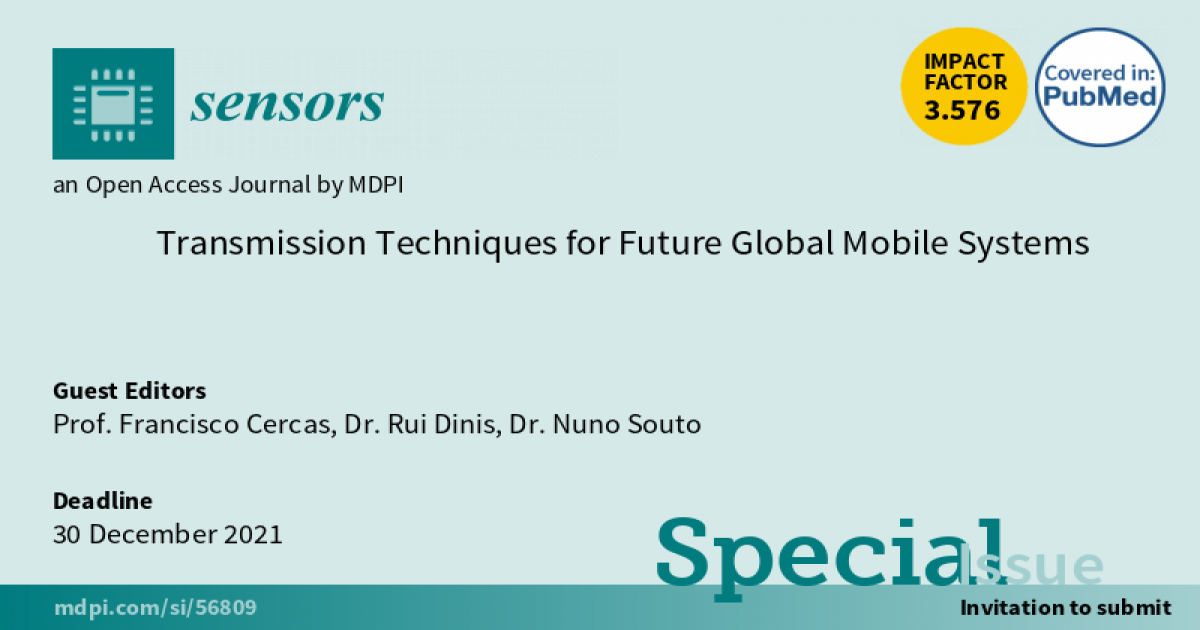Transmission Techniques for Future Global Mobile Systems
A special issue of Sensors (ISSN 1424-8220). This special issue belongs to the section "Communications".
Deadline for manuscript submissions: closed (30 December 2021) | Viewed by 44204

Special Issue Editors
Interests: intelligent communications; wireless and wired general communications for smart environments; Internet of Things; healthcare; air quality monitoring
Special Issues, Collections and Topics in MDPI journals
Interests: wireless communications; wireless systems
Special Issues, Collections and Topics in MDPI journals
2. Instituto de Telecomunicacoes, Lisbon, Portugal
Interests: signal processing for communications; communication signal transmission; reception and detection algorithms; channel estimation and modeling; MIMO communications; performance analysis of communication systems; optimization techniques in wireless communications; wireless, ad hoc and sensor networks
Special Issue Information
Dear Colleagues,
While 5G is progressively being implemented all around the world, it is time to develop better technologies for future communications. Requirements include ubiquitous and full connectivity anywhere in the globe, be it in places with good infrastructures, like great cities and smart cities, where a massive number of phones, sensors, drones, wearables, robots, cars, and all kinds of smart objects coexist, or in other places with little or no infrastructure, like rural places, or even at the sea, the poles or the desert, be it steady or moving at high speeds, such as on an airplane or a high-speed train.
Global coverage and high availability require a satellite component, so a distributed and decentralized infrastructure aided by artificial intelligence algorithms will decide, without the need for user intervention, the best possible resources to accomplish the required quality of service, such as high reliability, very low latency, high bandwidth, and/or other requirements. All of this must also work with high energy efficiency and minimum-security risks, so users can trust the system. Future networks and this connected way of life will become the so-called 4th utility.
For this dream to become true it is necessary to improve on the existing 5G system with new ideas and proposals, and that is the purpose of this Special Issue. We invite all the academic community, researchers, and leaders from the industry, and innovators, to contribute with great new ideas for our common and global connected world.
Prof. Francisco Cercas
Prof. Rui Dinis
Prof. Nuno Souto
Guest Editors
Manuscript Submission Information
Manuscripts should be submitted online at www.mdpi.com by registering and logging in to this website. Once you are registered, click here to go to the submission form. Manuscripts can be submitted until the deadline. All submissions that pass pre-check are peer-reviewed. Accepted papers will be published continuously in the journal (as soon as accepted) and will be listed together on the special issue website. Research articles, review articles as well as short communications are invited. For planned papers, a title and short abstract (about 250 words) can be sent to the Editorial Office for assessment.
Submitted manuscripts should not have been published previously, nor be under consideration for publication elsewhere (except conference proceedings papers). All manuscripts are thoroughly refereed through a single-blind peer-review process. A guide for authors and other relevant information for submission of manuscripts is available on the Instructions for Authors page. Sensors is an international peer-reviewed open access semimonthly journal published by MDPI.
Please visit the Instructions for Authors page before submitting a manuscript. The Article Processing Charge (APC) for publication in this open access journal is 2600 CHF (Swiss Francs). Submitted papers should be well formatted and use good English. Authors may use MDPI's English editing service prior to publication or during author revisions.
Keywords
- Beyond 5G
- Reconfigurable intelligent surfaces
- Radio stripes
- THz communications
- New waveforms and modulations
- Channel coding, estimation, and tracking
- Massive MIMO
- Physical layer security
- Simultaneous wireless information and power transference
- Global mobile satellite communications
Benefits of Publishing in a Special Issue
- Ease of navigation: Grouping papers by topic helps scholars navigate broad scope journals more efficiently.
- Greater discoverability: Special Issues support the reach and impact of scientific research. Articles in Special Issues are more discoverable and cited more frequently.
- Expansion of research network: Special Issues facilitate connections among authors, fostering scientific collaborations.
- External promotion: Articles in Special Issues are often promoted through the journal's social media, increasing their visibility.
- Reprint: MDPI Books provides the opportunity to republish successful Special Issues in book format, both online and in print.
Further information on MDPI's Special Issue policies can be found here.








